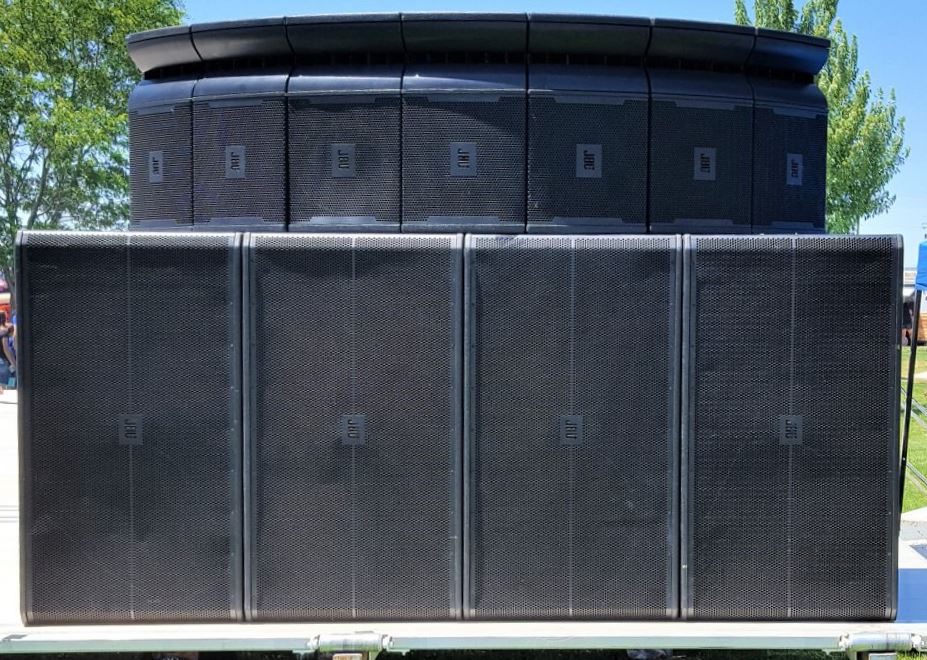It works because a JBL VRX module is a point-source box.
Please Remember:
The opinions expressed are mine only. These opinions do not necessarily reflect anybody else’s opinions. I do not own, operate, manage, or represent any band, venue, or company that I talk about, unless explicitly noted.

 Want to use this image for something else? Great! Click it for the link to a high-res or resolution-independent version.
Want to use this image for something else? Great! Click it for the link to a high-res or resolution-independent version.At a recent gig celebrating our country’s independence from a country that spells certain words with an extra “u,” we deployed a VRX system by stacking it upon SRX subwoofers.
As the picture shows, though, the stack was horizontal instead of vertical.
Was this “wrong?”
No.
It was unorthodox, but it was 100% in accordance with the fundamental design of JBL’s VRX modules. That is, a VRX system’s top-level design orthodoxy is for a vertically oriented array of modules…but remove the specialized hardware and each module is just a point-source box.
A VRX system is not a line array. I know people call it that. I know JBL’s own website uses “line array” in the descriptive blurbs. It’s called a line array because that’s what people search for, and buy, and market to their end clients. The modules can be hung or mounted vertically, and the result looks like the down-fire coverage of those big hangs at concerts, and that impresses people, and they hire you again, and they recommend you to their friends.
That’s all fine.
But a VRX system is not a line array. It’s not built such that several modules together combine to radiate in a pattern that’s more cylindrical than spherical. It’s built such that any particular listener is meant to be hearing as few boxes at a time as possible – ideally, only one box. Of course, the low-frequency sections interact pretty strongly. There’s nothing that can be done about that, because there’s nothing about a VRX box that can give you tight pattern control below about 2kHz anyway.
So, anyway, a VRX system is a point-source system. It’s just that, module per module, the vertical HF coverage is quite tight – about 30 degrees at 2kHz, narrowing to 15 degrees by the time you get to 5kHz or thereabouts. The problem, then, is if you turn the box on its side, you don’t get much coverage in the horizontal plane. Even three boxes together only get you 45 degrees of “guaranteed” coverage through the entire VRX bandwidth.
At such a point, you’ve got a choice. If you’ve brought 8 VRX modules to the show, and want to go horizontal, you could do two arrays of four. Your consistent coverage angle with the boxes on their sides is then 60 degrees per cluster. To handle a need for wider coverage, you then have to crossfire the clusters somewhat (or use center fills). That’s not a horrible thing, but there is another choice if you aren’t really attached to:
A) Stereo, or
B) Having things look normal.
That other choice is a monoblock. Pile all the subwoofers together, and array 7 VRX modules in a big arc on top. You get more output, because the tight-packed enclosures are more in phase with each other, more overall coherence because of the same thing, and your full-bandwidth coverage is 100 degrees by 100 degrees. The folks to the sides get some attention, and the folks up the hill also stay in the pattern.
Are there issues? Sure. Anytime you have multiple sources you will get some interference weirdness at certain places and frequencies. You’ll get swishing when the wind blows. That happens with orthodox deployments and unorthodox deployments. What changes is the specifics. In any case, you decide what you can live with and what you can’t, try to tune the system so that the majority of the audience is getting a nice show, and shrug your shoulders about everything else. The monoblock was definitely crispy up close, and also high-mid hot when you walked away up the hill. That aggressiveness had to be tamed with EQ – but it could be tamed.
Unorthodox isn’t a synonym for “wrong,” although there are plenty of unorthodox deployments that are very bad ideas. In this case, though, the system 100% supported what we were doing, and I felt that the results worked out well. We could have done something traditional by center-clustering the subs and running side-by-side mounts of two boxes per stick, plus outfills…
…but that would have been boring, and it wouldn’t have worked any better. To be frank, if we had the resources to fly the monoblock array over downstage center, I’d probably push for that as a common way of us doing things. One big source that’s more coherent because all the elements are closer together? Yes, please.